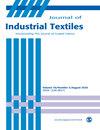A systematic review of released nano-particles from commercial nano-textiles during use and washing
IF 2
4区 工程技术
Q1 MATERIALS SCIENCE, TEXTILES
引用次数: 0
Abstract
The increasing demand for durable, eco-friendly clothing has led to the use of nanomaterials in textiles. However, concerns arise about the impact of engineered nanomaterials (ENMs). Studies have explored nanoparticle release from textiles during usage and washing. However, the existing data is fragmented, and a comprehensive grasp is absent. A systematic review is required to consolidate existing evidence and offer a thorough analysis of nanoparticle release from nano-enhanced textiles in commercial use and washing. This review assess the research aims to concerning the release of nanomaterials from commercial textiles during usage and laundering. The process involved defining objectives, crafting a search strategy, utilizing databases, and applying inclusion/exclusion criteria. After deduplication, articles were screened for eligibility, covering nanoparticle characteristics and release mechanisms. Searches spanned Scopus, PubMed, and Web of Science, using keywords like “Nano,” “Nanoparticles,” etc. Original articles on nanomaterial release from conventional textiles were included. Out of 1549 articles identified, and met the criteria for inclusion in the study. The results reveal that textiles employing nanotechnology can indeed release a significant quantity of nanoparticles. The characteristics of these released particles, including their quantity and composition, are influenced by various factors such as nanoparticle structure, adhesive properties, fabric type, and environmental interactions. While there exist variations between laboratory simulations and real-world conditions, these findings underscore potential risks associated with nanoparticle release, underscoring the necessity for toxicological assessments and additional research into particle behavior, particularly emphasizing the functional aspects of fibers and the environmental impact following nanoparticle release after washing.对商用纳米纺织品在使用和洗涤过程中释放的纳米颗粒进行系统审查
人们对耐用、环保服装的需求日益增长,促使纳米材料在纺织品中的应用。然而,人们对工程纳米材料(ENMs)的影响表示担忧。已有研究探讨了纺织品在使用和洗涤过程中的纳米颗粒释放问题。然而,现有数据比较零散,缺乏全面的把握。有必要进行一次系统回顾,以整合现有证据,并对纳米增强纺织品在商业使用和洗涤过程中的纳米粒子释放情况进行全面分析。本综述旨在评估有关商用纺织品在使用和洗涤过程中纳米材料释放的研究。研究过程包括确定目标、制定搜索策略、利用数据库以及应用纳入/排除标准。经过去重后,筛选出符合条件的文章,内容包括纳米粒子的特性和释放机制。搜索范围包括 Scopus、PubMed 和 Web of Science,使用的关键词包括 "纳米"、"纳米颗粒 "等。其中包括有关传统纺织品中纳米材料释放的原创文章。在已确定的 1549 篇文章中,符合纳入研究的标准。研究结果表明,采用纳米技术的纺织品确实可以释放大量纳米粒子。这些释放颗粒的特性,包括其数量和组成,受到各种因素的影响,如纳米颗粒结构、粘合剂特性、织物类型和环境相互作用。虽然实验室模拟和实际条件之间存在差异,但这些发现强调了与纳米粒子释放相关的潜在风险,突出了对粒子行为进行毒理学评估和更多研究的必要性,特别强调了纤维的功能性以及纳米粒子在洗涤后释放对环境的影响。
本文章由计算机程序翻译,如有差异,请以英文原文为准。
求助全文
约1分钟内获得全文
求助全文
来源期刊

Journal of Industrial Textiles
MATERIALS SCIENCE, TEXTILES-
CiteScore
5.30
自引率
18.80%
发文量
165
审稿时长
2.3 months
期刊介绍:
The Journal of Industrial Textiles is the only peer reviewed journal devoted exclusively to technology, processing, methodology, modelling and applications in technical textiles, nonwovens, coated and laminated fabrics, textile composites and nanofibers.
 求助内容:
求助内容: 应助结果提醒方式:
应助结果提醒方式:


